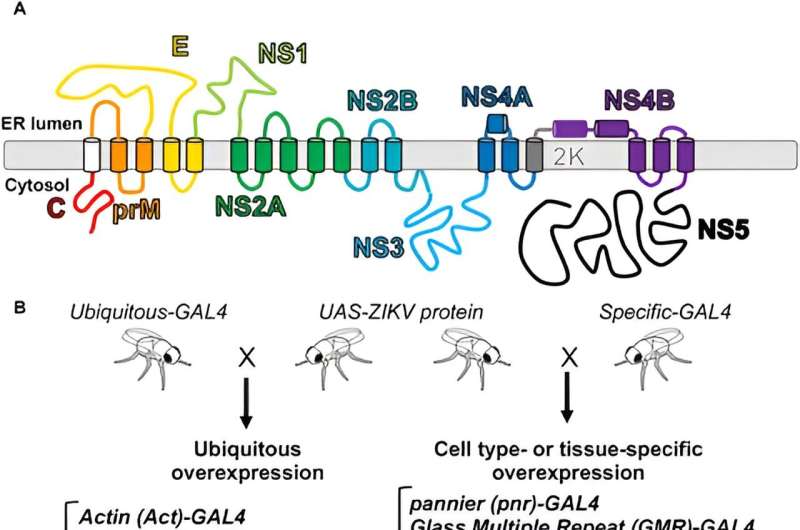This article has been reviewed according to Science X's editorial process and policies. Editors have highlighted the following attributes while ensuring the content's credibility:
fact-checked
trusted source
proofread
Researchers develop a new toolkit of fruit flies to study Zika virus

To study how Zika virus proteins hijack and disrupt host developmental pathways during infection and disease progression, Dr. Shinya Yamamoto, assistant professor at Baylor College of Medicine and principal investigator at the Jan and Dan Duncan Neurological Research Institute; Dr. Nichole Link, assistant professor at the University of Utah; and colleagues have generated a toolkit of transgenic flies expressing all ten Zika virus proteins.
The collaborative study, published in the journal Disease Models & Mechanism, has created a valuable resource for researchers all over the world to conduct in-depth investigations into the pathogenesis of this virus and the potential impact of new strains that emerge over time as this virus mutates.
Using flies to generate a new toolkit
In the past decade, the Zika virus has emerged as a concern for global public health. While Zika virus infections are mild in most adults, such an infection during pregnancy leads to a serious birth defect called microcephaly, associated with decreased brain size. Other severe adverse outcomes including poor muscle tone and developmental delays also occur in babies. Additionally, in some adults, Zika virus infections have been linked to severe neurological conditions and seizures. Together, these symptoms hint at the broad role of the Zika virus in brain development, neuronal function, and post-developmental processes.
Understanding the precise molecular pathways and mechanisms this virus impacts during fetal development, and particularly brain development, is of critical importance to developing targeted therapies in the future.
The newly generated transgenic flies allow researchers to express all ten Zika virus proteins, which include three structural proteins and seven non-structural (NS) proteins, in all or specific tissues. The authors performed a series of assays to screen the impact of these viral proteins on the developing nervous system.
Transgenic flies expressing Zika proteins recapitulate patient symptoms
Using a systems-level approach to identify potential targets of ZIKV, the Duncan NRI team had previously found that Zika virus protein NS4A interacts with and disrupts the function of human ANKLE2, a protein involved in cell division whose disruption causes microcephaly.
"We found that expression of most Zika proteins induced measurable, diverse yet tissue-specific effects such as lethality, reduced brain size, and functional defects indicative of disruptions in specific pathways rather than general cellular toxicity," Dr. Link added. "Notably, we validated our previous finding that the expression of NS4A protein disrupts brain development via the ANKLE2 pathway and identified additional Zika virus proteins, NS4B, and fused NS2B::NS3, as novel regulators of brain size when expressed in flies."
In agreement with increasing evidence of post-developmental effects of the Zika virus on neuronal function beyond microcephaly, the expression of several Zika proteins including NS4A, NS4B, and fused prM::E in post-differentiated photoreceptor cells in the Drosophila eye causes functional degeneration as flies age.
"We are especially interested in the finding that NS4A can cause age-dependent neurodegeneration in the fly visual system, which warrants further investigation," Dr. Yamamoto explained.
Fruit flies as a model to study viral evolution
Lastly, the authors found these transgenic flies can be used as a screening tool to study the biological effects of mutations acquired by different Zika strains as the virus evolves. For instance, compared to the NS1 protein from the French Polynesian strain, the NS1 protein from the Puerto Rican strain, which is implicated in recent epidemics and is known to cause severe microcephaly, was more toxic to flies when overexpressed ubiquitously or in a tissue-specific manner.
"Overall, our work has generated a new experimental paradigm and set of essential tools that researchers can use to test the impact of various Zika proteins and its different strains on host pathways, which will be valuable for developing new molecularly targeted therapies to treat these infections,", Dr. Yamamoto added.
Others involved in the work were Michael Harnish, Brooke Hull, Shelley Gibson, Miranda Dietze, Uchechukwu E. Mgbike, Silvia Medina-Balcazar, and Priya S. Shah.
More information: Nichole Link et al, A Zika virus protein expression screen in Drosophila to investigate targeted host pathways during development, Disease Models & Mechanisms (2024). DOI: 10.1242/dmm.050297



















